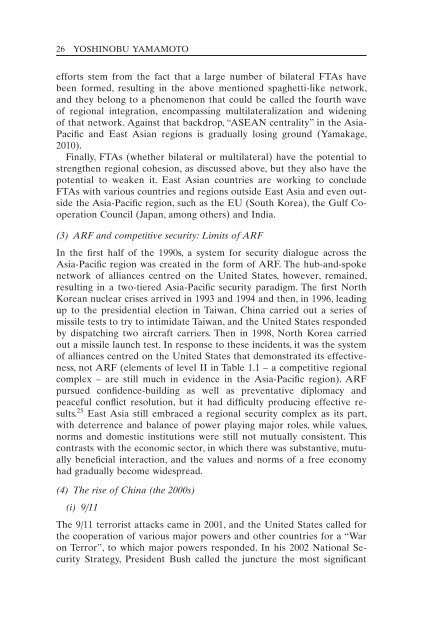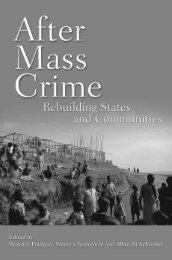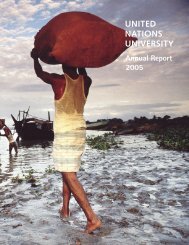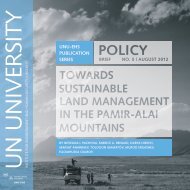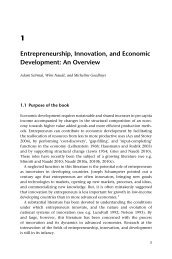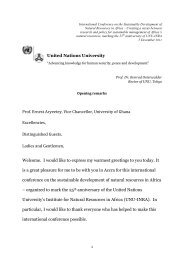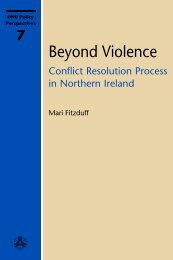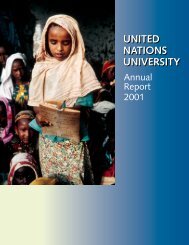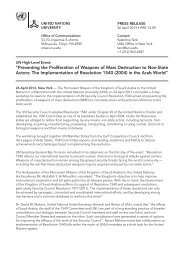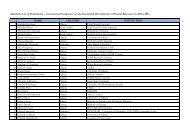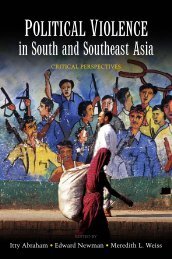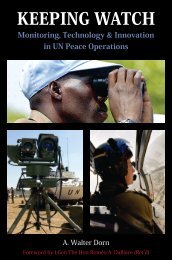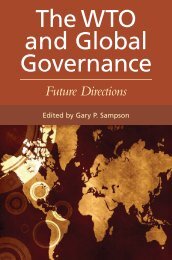Sample Chapter - United Nations University
Sample Chapter - United Nations University
Sample Chapter - United Nations University
You also want an ePaper? Increase the reach of your titles
YUMPU automatically turns print PDFs into web optimized ePapers that Google loves.
26 Yoshinobu Yamamoto<br />
efforts stem from the fact that a large number of bilateral FTAs have<br />
been formed, resulting in the above mentioned spaghetti-like network,<br />
and they belong to a phenomenon that could be called the fourth wave<br />
of regional integration, encompassing multilateralization and widening<br />
of that network. Against that backdrop, “ASEAN centrality” in the Asia-<br />
Pacific and East Asian regions is gradually losing ground (Yamakage,<br />
2010).<br />
Finally, FTAs (whether bilateral or multilateral) have the potential to<br />
strengthen regional cohesion, as discussed above, but they also have the<br />
potential to weaken it. East Asian countries are working to conclude<br />
FTAs with various countries and regions outside East Asia and even outside<br />
the Asia-Pacific region, such as the EU (South Korea), the Gulf Cooperation<br />
Council (Japan, among others) and India.<br />
(3) ARF and competitive security: Limits of ARF<br />
In the first half of the 1990s, a system for security dialogue across the<br />
Asia-Pacific region was created in the form of ARF. The hub-and-spoke<br />
network of alliances centred on the <strong>United</strong> States, however, remained,<br />
resulting in a two-tiered Asia-Pacific security paradigm. The first North<br />
Korean nuclear crises arrived in 1993 and 1994 and then, in 1996, leading<br />
up to the presidential election in Taiwan, China carried out a series of<br />
missile tests to try to intimidate Taiwan, and the <strong>United</strong> States responded<br />
by dispatching two aircraft carriers. Then in 1998, North Korea carried<br />
out a missile launch test. In response to these incidents, it was the system<br />
of alliances centred on the <strong>United</strong> States that demonstrated its effectiveness,<br />
not ARF (elements of level II in Table 1.1 – a competitive regional<br />
complex – are still much in evidence in the Asia-Pacific region). ARF<br />
pursued confidence-building as well as preventative diplomacy and<br />
peaceful conflict resolution, but it had difficulty producing effective results.<br />
25 East Asia still embraced a regional security complex as its part,<br />
with deterrence and balance of power playing major roles, while values,<br />
norms and domestic institutions were still not mutually consistent. This<br />
contrasts with the economic sector, in which there was substantive, mutually<br />
beneficial interaction, and the values and norms of a free economy<br />
had gradually become widespread.<br />
(4) The rise of China (the 2000s)<br />
(i) 9/11<br />
The 9/11 terrorist attacks came in 2001, and the <strong>United</strong> States called for<br />
the cooperation of various major powers and other countries for a “War<br />
on Terror”, to which major powers responded. In his 2002 National Security<br />
Strategy, President Bush called the juncture the most significant


